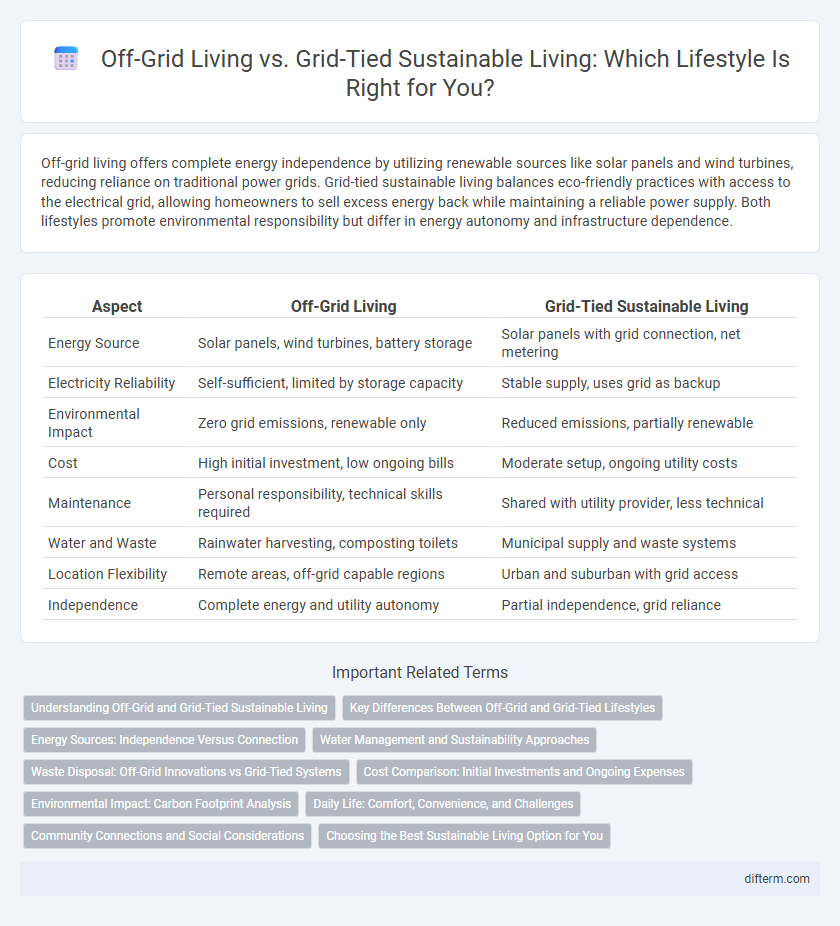Off-grid living offers complete energy independence by utilizing renewable sources like solar panels and wind turbines, reducing reliance on traditional power grids. Grid-tied sustainable living balances eco-friendly practices with access to the electrical grid, allowing homeowners to sell excess energy back while maintaining a reliable power supply. Both lifestyles promote environmental responsibility but differ in energy autonomy and infrastructure dependence.
Table of Comparison
| Aspect | Off-Grid Living | Grid-Tied Sustainable Living |
|---|---|---|
| Energy Source | Solar panels, wind turbines, battery storage | Solar panels with grid connection, net metering |
| Electricity Reliability | Self-sufficient, limited by storage capacity | Stable supply, uses grid as backup |
| Environmental Impact | Zero grid emissions, renewable only | Reduced emissions, partially renewable |
| Cost | High initial investment, low ongoing bills | Moderate setup, ongoing utility costs |
| Maintenance | Personal responsibility, technical skills required | Shared with utility provider, less technical |
| Water and Waste | Rainwater harvesting, composting toilets | Municipal supply and waste systems |
| Location Flexibility | Remote areas, off-grid capable regions | Urban and suburban with grid access |
| Independence | Complete energy and utility autonomy | Partial independence, grid reliance |
Understanding Off-Grid and Grid-Tied Sustainable Living
Off-grid living involves complete self-sufficiency, relying on renewable energy sources like solar panels and wind turbines, water collection systems, and waste management independent of public utilities. Grid-tied sustainable living combines renewable energy generation with connection to the local power grid, allowing users to export excess energy and draw power when renewable sources are insufficient. Understanding the balance between autonomy and grid support helps optimize energy efficiency, environmental impact, and lifestyle flexibility in sustainable living choices.
Key Differences Between Off-Grid and Grid-Tied Lifestyles
Off-grid living relies entirely on self-sustained energy sources like solar panels and wind turbines, promoting complete independence from public utilities. Grid-tied sustainable living integrates renewable energy with the local power grid, allowing for energy trading and backup when renewable sources are insufficient. Key differences include autonomy levels, initial setup costs, and dependency on infrastructure, influencing lifestyle flexibility and environmental impact.
Energy Sources: Independence Versus Connection
Off-grid living relies primarily on renewable energy sources like solar panels and wind turbines to achieve complete energy independence, reducing reliance on external utilities and promoting self-sufficiency. Grid-tied sustainable living integrates renewable energy with the traditional power grid, enabling surplus energy to be sold back to the utility company while maintaining a stable energy supply during periods of low production. This connection offers flexibility and security but limits total energy autonomy compared to off-grid systems.
Water Management and Sustainability Approaches
Off-grid living relies heavily on rainwater harvesting, greywater recycling, and onsite natural filtration systems to achieve water self-sufficiency and reduce environmental impact. Grid-tied sustainable households typically use advanced smart meters, leak detection technology, and municipal water treatment services to optimize water efficiency and minimize waste. Both lifestyles prioritize sustainable water management practices, but off-grid systems emphasize complete independence while grid-tied solutions focus on integration with centralized infrastructure.
Waste Disposal: Off-Grid Innovations vs Grid-Tied Systems
Off-grid living employs innovative waste disposal methods such as composting toilets, greywater recycling systems, and bio-digesters that minimize environmental impact and enhance self-sufficiency. Grid-tied sustainable homes typically utilize municipal waste services combined with advanced onsite technologies like automated composters and smart water treatment to efficiently manage waste while maintaining connectivity to infrastructure. Both approaches aim to reduce carbon footprints, but off-grid systems prioritize autonomy and resource recycling, whereas grid-tied systems leverage networked solutions for waste management optimization.
Cost Comparison: Initial Investments and Ongoing Expenses
Off-grid living typically requires higher initial investments in solar panels, battery storage, and water systems, while grid-tied sustainable homes benefit from lower upfront costs by leveraging existing infrastructure. Ongoing expenses for off-grid setups include battery replacements and fuel for backup generators, whereas grid-tied systems incur regular utility fees, albeit reduced by energy savings and net metering credits. Evaluating total cost of ownership over time often reveals grid-tied sustainable living as more cost-effective for most homeowners.
Environmental Impact: Carbon Footprint Analysis
Off-grid living significantly reduces carbon footprints by relying on renewable energy sources such as solar or wind, minimizing dependence on fossil-fuel-based electricity grids. In contrast, grid-tied sustainable living often incorporates green energy options but may still draw power from conventional energy plants, resulting in a moderate carbon footprint. Lifecycle emissions from energy production, transportation, and storage are generally lower in off-grid systems, promoting more eco-friendly lifestyles with reduced environmental impacts.
Daily Life: Comfort, Convenience, and Challenges
Off-grid living offers unparalleled self-sufficiency and peace, relying on renewable energy sources like solar and wind, but it demands meticulous resource management and adaptation to intermittent power availability. Grid-tied sustainable living provides consistent electricity and modern comforts, leveraging the grid as a reliable backup while integrating green technologies such as solar panels and energy-efficient appliances. Challenges in off-grid setups include energy storage limitations and water conservation, whereas grid-tied residents must navigate utility costs and potential infrastructure vulnerabilities.
Community Connections and Social Considerations
Off-grid living fosters strong community bonds through shared resources and mutual support, creating tight-knit networks essential for sustainability and resilience. In contrast, grid-tied sustainable living often relies on broader infrastructure, which can lead to more dispersed social connections and less immediate community interaction. Both lifestyles require deliberate efforts to cultivate social cohesion, but off-grid settings naturally prioritize face-to-face engagement for problem-solving and resource management.
Choosing the Best Sustainable Living Option for You
Off-grid living offers complete energy independence through solar panels, wind turbines, and water collection systems, providing a self-sufficient lifestyle ideal for remote areas. Grid-tied sustainable living combines renewable energy with conventional utilities, allowing for lower upfront costs and energy sharing via net metering programs. Assess factors like location, budget, and personal sustainability goals to determine the best option that balances autonomy with convenience and environmental impact.
off-grid living vs grid-tied sustainable living Infographic

 difterm.com
difterm.com